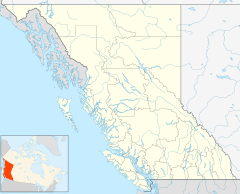Cheslatta Carrier Nation facts for kids
Quick facts for kids
Cheslatta Carrier Nation
Cheslatta T'En
Band number 620
|
|
|---|---|
| Country | |
| Government | |
| • Type | First Nations Council |
| Time zone | [[UTC-7 UTC−7]] (Pacific Time Zone (PTZ)) |
| • Summer (DST) | DST |
| Postal code span |
V0J 1E0
|
| Area code(s) | 250 |
| Band Office Box 909, Southbank, Burns Lake, BC | |
The Cheslatta Carrier Nation or Cheslatta T'En (pronounced chez-la-ta) is a First Nation group in British Columbia, Canada. They are part of the larger Carrier people (pronounced tákʰɛɬ), also known as "Ta-cullies," which means "people who go upon water." Their traditional lands were located around the Nechako River, which flows into the Fraser River.
For many centuries, the Cheslatta T'en lived by hunting, fishing, and trapping in this area. They were also part of an old trading network called the Grease Trail. This trail was used to trade "grease," which was actually oil from a fish called the eulachon. This oil was very valuable and was traded with other First Nations groups like the Nuxalk and Tsilhqotʼin.
In 1952, the Cheslatta village and Cheslatta Lake were flooded. This happened because the Kenney Dam was built, which created the huge Nechako Reservoir. Today, most Cheslatta members live on several small reserves south of Francois Lake. Their main office is in Southbank, about 23 kilometers south of Burns Lake. In 2013, the Cheslatta Carrier Nation had 340 members, with 125 living on their reserves.
Contents
Language and Culture
The Cheslatta people speak a dialect of the Carrier language called Cheslatta or Dakelh. This language belongs to the Dene (Athabaskan) family of languages. While many members are learning the language, only a small number are fluent speakers.
The Carrier language is generally divided into two main groups: Upper Carrier and Lower Carrier. Upper Carrier is spoken in areas north of Fort St. James. Lower Carrier is spoken in southern communities, including Prince George, Cheslatta, and others.
Community Leadership
The Cheslatta Carrier Nation is led by a Chief and Councillors. As of 2015–2018, Corrina Leween is the Chief, and Hazel Burt and Ted Jack are the Councillors.
The Cheslatta Carrier Nation is part of the British Columbia Assembly of First Nations (BCAFN). This organization represents 203 First Nations groups across British Columbia. It works to support and advocate for their rights and interests.
History of the Cheslatta People
For hundreds of years, the Cheslatta T'en lived and thrived in the lands around the Nechako River and Fraser River. They also used areas near the West Road River and Bulkley River, and lakes like Stuart Lake and Babine Lake. Their traditional territory even stretched east to the Rocky Mountains.
They fished for different types of fish like trout and whitefish in the freshwater lakes. They also traded with nearby villages for salmon. In later years, many Cheslatta people grew large vegetable gardens and raised cattle and horses. Some also worked at local sawmills or for ranchers, and they trapped animals to earn money for supplies they couldn't make themselves.
In the late 1700s, Alexander Mackenzie, a European explorer, was guided by Nuxalk-Carrier people along the ancient Grease Trail. This trail helped connect different communities for trade.
The Flooding of Traditional Lands
A major event in Cheslatta history was the flooding of their traditional lands in the 1950s. This happened because of a large hydroelectric project. In 1950, the British Columbia government and a company called Alcan (now Rio Tinto Alcan) agreed to build a dam to create power for an aluminum factory.
The Kenney Dam was built, and the Nechako Reservoir began to fill in October 1952. By 1954, the dam was finished, creating a huge lake that covered 339 square miles and was 145 miles long. This project caused the Nechako River's flow to stop completely in some areas.
When the reservoir filled, it flooded the Cheslatta village and their traditional lands. The community was forced to move quickly to new areas. This change was difficult for them, as they had to adapt to a new way of life. The company built a stone marker at the highest point of the flooded village site on Ootsa Lake.
Later, some water was released back into the Nechako River through the Cheslatta River. However, this caused problems like deep channels forming and a lot of sediment being deposited. Homes and a graveyard of the local First Nation community were flooded again because of a smaller dam. The Cheslatta Carrier Nation later received a payment from the Canadian government in 1993 for the difficulties they faced due to the flooding.
Economic Development
The Cheslatta Carrier Nation has worked on several projects to help their community grow.
Cheslatta Forest Products
In 1996, the Cheslatta Carrier Nation gained the rights to salvage trees that were submerged (underwater) because of the Kemano power project. In 2001, they partnered with two other companies to form Cheslatta Forest Products. This partnership built a sawmill near Ootsa Lake. The sawmill processed timber from underwater and trees affected by the mountain pine beetle. This project helped create jobs and economic opportunities for the community.
Community Programs
The Cheslatta Carrier Nation has also developed important social and educational programs.
In 2004, they completed a modern water filtration system. This system pumps water from Francois Lake, filters it, and then delivers clean water to their community. It also serves the neighboring Skin Tyee Band and Nee Tahi Buhn Band, as well as non-native communities in the area.
The Cheslatta Carrier Nation is also building an online archive. This archive will help preserve their history and culture, including information from before and after the major flooding event.


